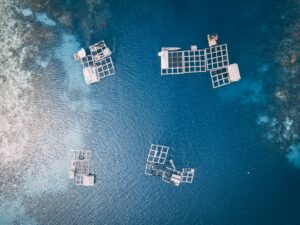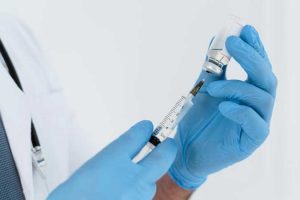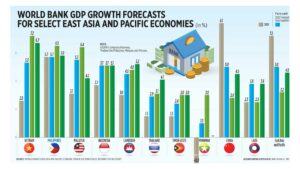Closer economic ties with Taiwan: Aquaculture

Another sector in which closer ties between the Philippines and Taiwan will greatly benefit our attaining food security is that of aquaculture in which, with the appropriate investments from both the public and private sectors, our country can literally leapfrog into high-technology production of fish products for our growing population. This is especially important because fish and other aquaculture products constitute a major component of the Filipino diet.
As reported by Paula Arab, like elsewhere in the Taiwanese economy, high-tech is playing an emerging and key role in the country’s fisheries, particularly in the aquaculture sector. This island country is already showcasing aquaculture practices that integrate collaboration with smart industries such as biological technology, artificial intelligence and the Internet of Things (IoT).
At a glance, Taiwan’s aquaculture industry can be described as follows:
28% of the country’s fish production comes from aquaculture.
42,000 hectares of aquaculture
Taiwan’s aquaculture history dates back 300 years
Taiwan’s marine aquaculture is divided into three categories: shallow sea culture, marine cage culture, and salt water pond culture.
Grouper has become the most important aquaculture species today, after the Fisheries Research Institute (FRI) successfully established the technology of its artificial propagation in 1982.
Tilapia is another one of the country’s most important aquaculture species. The FRI has introduced various tilapia species and developed hybrids for aquaculture, such as red tilapia, monosex tilapia, and seawater tilapia.
The most recent initiative to profit from advanced aquaculture technology from Taiwan is a proposal from an entrepreneur from Cavite to establish an aquaculture training center in Maragondon, Cavite.
Maragondon is just 66 kilometers from Manila via the R1-Antero Soriano Highway, or barely a two-hour drive away from the National Capital Region (NCR). The Philippine Naval Station at Ternate, Cavite, has identified the strategic site of Maragondon for development as an aquaculture training center to enhance the opportunities for aquaculture training within the Cavite-Batangas-Mindoro-Bataan areas. The biggest market for aquaculture products, Metro Manila, is just around the corner. Once the bridge connecting Cavite to Bataan, passing through Corregidor, is constructed, the market will be even further expanded to include the emerging metropolis of Central Luzon.
A group of Filipino entrepreneurs, led by Guillermo Choa and Arsenio Barcelona, are eyeing a partnership with Taiwan technology institutions through the Taipei Economic and Cultural Office with its counterpart, the Manila Economic and Cultural Office (TECO-MECO) to put up a training center of aquaculture and hatchery technology transfers.
Mr. Choa is willing to support the establishment of this center by leasing land in Maragondon that can be used for 30 years under a usufruct agreement, and funding a training facility for Filipino aquaculturists, aquaculture science students and teachers. This center can be located within an area with more than 1,000 hectares. Mr. Choa is willing to negotiate with private Taiwanese aquaculture entrepreneurs and the Taiwan Aquaculture Research Institute to develop the aquaculture industry in Maragondon, which, as described above, is ideally located to serve the huge market for aquaculture products of populous Metro Manila and Central Luzon.
The private business sector led by Mr. Choa will provide the funding for the Training Center Building, composed of two lecture rooms with audio-video facilities. Each room will have a capacity for 30 persons. There will be a movable partition between the two rooms so that they can be expanded into one big lecture hall for 100. There will be residential facilities for management and maintenance staff. Ten hectares will be available for aquaculture ponds for finfish and shrimps, an Algae and Seaweeds Research Institute, and a future building to house a full-blown School of Aquaculture.
The Cavite Aquaculture Center will take care of developing training syllabi and hands-on mentoring modules for trainees, which can eventually be shared with aquaculture training centers in state colleges and universities as well as local government units in coastal municipalities. People trained in these aquaculture centers can become mentors who will train others equipped with an “agribusiness sense,” enabling them to manage aquaculture farms all over the country efficiently and, more importantly, profitably.
Government policies and support should provide the necessary infrastructure for aquaculture zones that have the environmental conditions that can protect the quality of the land and water resources within each area. Government regulations should be strictly implemented but should be investor friendly.
What President Ferdinand Marcos, Jr. promised farmers in his SONA should also be made available to the fishing or aquaculture industry because fisherfolk are also among the poorest Filipinos. Road networks, electricity, manpower development, aquaculture inputs suppliers’ support, processing technology transfer, cold chain, distribution and marketing channels should be included in the industry roadmap.
If we are able to produce more than what can be sold to the domestic consumers, China and Japan are big markets nearby. This prospect for exporting aquaculture products to China and Japan should be another reason we should ratify the Regional Comprehensive Economic Partnership (RCEP) as soon as possible.
The Maragondon project should be replicated in other provinces and municipalities that are rich in aquaculture resources such as Pangasinan, Iloilo, Negros Occidental, San Jose (Mindoro Occidental), General Santos, and many others. Local government officials, in tandem with private entrepreneurs like Mr. Choa and Mr. Barcelona, should reach out to Taiwanese officials who are more than willing to transfer both capital and technology to the Philippines to help us achieve food security.
In their Southbound policy, it is obvious that the Philippines is the very first country that they will consider to help. It is also providential that historically native Taiwanese culture and our own have very many things in common. It is about time that we take very seriously the many lessons we can learn from the most successful East Asian economy to achieve agro-industrial excellence.
BERNARDO M. VILLEGAS has a Ph.D. in Economics from Harvard, is professor emeritus at the University of Asia and the Pacific, and a visiting professor at the IESE Business School in Barcelona, Spain. He was a member of the 1986 Constitutional Commission.bernardo.villegas@uap.asia




